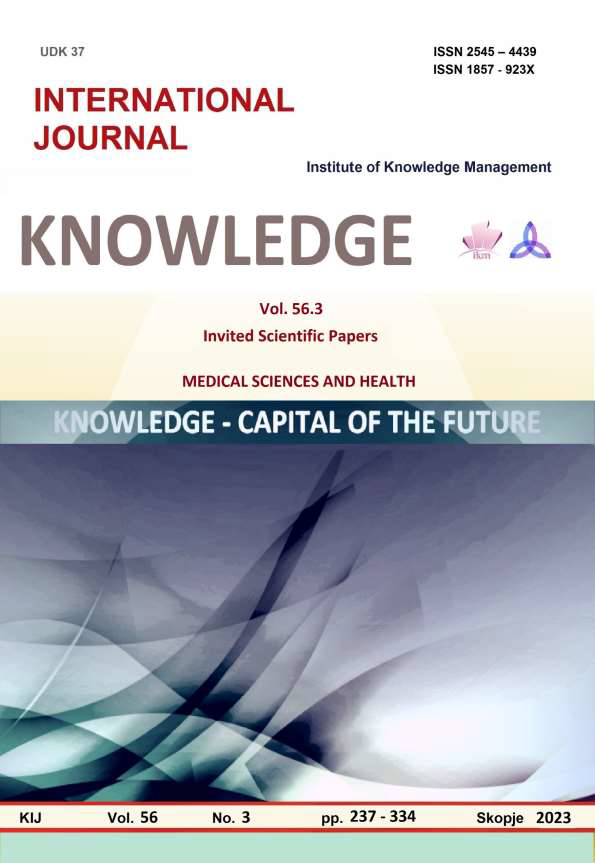QUANTITATIVE COMPUTED TOMOGRAPHY DENSITOMETRY IN EMPHYSEMA AND ITS RELATIONSHIP WITH QUALITATIVE VISUAL SCORING AND PULMONARY FUNCTION TESTS
Keywords:
emphysema, quantitative computed tomography (QCT), densitometry, visual score and pulmonary function tests (PFT)Abstract
Emphysema as common and rather pathological entity is classified among the chronic obstructive
pulmonary diseases (COPD) and defined as abnormal and irreparable increase in size of the airspaces located
caudally to the terminal bronchioles that may go along with alveolar wall destruction but no evident fibrosis. Not
only is CT being used as a regular diagnostic tool in the detection of emphysema, but in recent years offers a
phenotypic classification and quantification of lung abnormalities that assists the clinical characteristics of the
patients involved.
The aim of this study was to demonstrate significant correlation between quantitative CT densitometry on one side,
and the visually assessed CT subtypes as well as the function lung tests on the other side in patients with
emphysema.
In total of 10 patients diagnosed with emphysema, 8 male and 2 female, with the mean age of 61. 3± 14. 84 , who
underwent a CT exam, a quantitative CT densitometry was calculated and compared to 5 visually acquired CT
subtypes using the Fleischner Society classification: normal, bronchial disease and centrilobular emphysema ( trace,
mild and advanced destructive). A correlation was also made with the pulmonary function tests (FEV1 and FEV1/
FVC ratio).
There is a strong positive correlation which is statistically significant for p< 0.5 for the parameters of quantitative
assessment with -950HU calculated on the CT densitometry and the CT visual scoring, as well as statistically
significant and strong negative correlation between the pulmonary function tests, FEV1 and FEV1/ FVC ratio,
respectively. The pulmonary function tests, according to the Global Initiative for Chronic Obstructive Lung Disease
(GOLD), revealed that 30% of our patients had mild, severe and very severe obstructive defect respectively, where
only 10% had moderate obstructive defect.
Quantitative CT densitometry, already being a non- invasive study, also plays a major role in detecting, clearly
depicting and quantifying lung zones involved with emphysema and provides rapid evaluation of the severity of
emphysema. Quantitative CT densitometry with its accurate illustration of the extent and distribution of lung
abnormalities in emphysema may aid the selection of patients who are suitable for lung reduction surgery.
References
Abd elsalam et al. (2020). Egyptian Journal of Radiology and Nuclear. 51:160 https://doi.org/10.1186/s43055-020-00281-4
Bakker, M. E., Stolk, J., Putter, H. et al. (2005). Variability in densitometric assessment of pulmonary emphysema with computed tomography. Investig Radiol 40:777–783
Gevenois, P. A., De Vuyst, P., de Maertelaer, V., Zanen, J., Jacobovitz, D., Cosio, M. G. et al. (1996). Comparison of computed density and microscopic morphometry in pulmonary emphysema. Am J Respir Crit Care Med 154:187–192
Global Initiative for Chronic Obstructive Lung Disease. (2018). Global strategy for the diagnosis, management, and prevention of chronic obstructive pulmonary disease. http://www.goldcopd.org/guidelines-global-strategy-fordiagnosis-management.html
Han, M. K., Agusti, A., Calverley, P. M., Celli, B. R., Criner, G., Curtis, J. L. et al. (2010). Chronic obstructive pulmonary disease phenotypes: the future of COPD. Am J Respir Crit Care Med 182:598–604
Kang, H. S., Bak, S. H., Oh, H. Y., Lim, M. N., Cha, Y. K., Yoon, H. J., & Kim, W. J. (2021). Computed tomography-based visual assessment of chronic obstructive pulmonary disease: comparison with pulmonary function test and quantitative computed tomography. J Thorac Dis;13(3):1495-1506. doi: 10.21037/jtd-20-3041
Koo, H. J., Lee, S. M., Seo, J. B., et al. (2019) Prediction of Pulmonary Function in Patients with Chronic Obstructive Pulmonary Disease: Correlation with Quantitative CT Parameters. Korean J Radiol;20:683-92.
Lowe, K. E., Regan, E. A., Anzueto, A., et al. (2019). Redefining the Diagnosis of Chronic Obstructive Pulmonary Disease. Chronic Obstr Pulm Dis;6:384-99.
Lynch, D. A., Austin, J. H. M., Hogg, J. C., et al. (2015). CT-Definable Subtypes of Chronic Obstructive Pulmonary Disease: A Statement of the Fleischner Society. Radiology;277:192-205
Mets, O. M., de Jong, P. A., van Ginneken, B., Gietema, H. A., & Lammers, J. W. (2012). Quantitative computed tomography in COPD: possibilities and limitations. Lung.; 190: 133 –145.
Nhue, L. D., & Beek, Y. C. (2012). Chronic obstructive pulmonary disease: emphysema revisited, chronic obstructive pulmonary disease - Current Concepts and Practice, Dr. Kian-Chung Ong (Ed.), Available from:http://www.intechopen.com/books/chronic.obstructivepulmonary-disease-current-concepts-and-practice/chronic-obstructivepulmonary-disease-emphysema-revisited.
Park, J., Hobbs, B. D., Crapo, J. D., et al. (2020). Subtyping COPD by Using Visual and Quantitative CT Imaging Features. Chest;157:47-60.
Roca, J., Vargas, C., Cano, I., et al. (2014). Chronic Obstructive Pulmonary Disease heterogeneity: challenges for health risk assessment, stratification and management. J Transl Med;12 Suppl 2:S3.
Temizoz, O., Etlik, O., Emin, M., Uzun, K., Arslan, H., Harman, M. et al. (2007). Detection and quantification of the parenchymal abnormalities in emphysema using pulmo-CT. Comput Med Imag Grap 31:542–548
Wang, Z., Suicheng, G., Leader, J. K., Kundu, S., Tedrow, J. R., Sciurba, F. C. et al. (2013). Optimal threshold in CT quantification of emphysema. Eur Radiol 23:975–984





